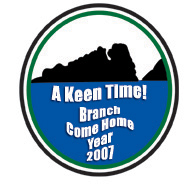


|
Branch Come Home Year August 9-19, 2007 |
|
Information About Branch From... Mrs. Agnes (Mooney) Singleton Submitted By: Marina (Power) Gambin
|

|
The following information (which is word for word as she wrote it) was sent to me in the early 1970s by my Great Aunt Aggie (Mooney) Singleton who was born in Branch and later married in St. Joseph’s, St. Mary’s Bay.
Aunt Aggie lived to be 99 years old. She would have been born in the mid 1800s.
So, in the words of Great Aunt Aggie Singleton:
For your information, I do not vouch for any of this I write being actual fact. We will call it hearsay.
John Skerry, an Irish emigrant, one of Sweetman’s fishermen, had settled in Ship Cove. His wife Alice Barry, who claimed to be the aunt of the Irish patriot Kevin Barry, came to join him in Newfoundland. When John Power settled in Branch, he married John Skerry’s daughter Catherine.
At that time, Branch had a few settlers, some of Lord Calvert’s staff, Lord Calvert being called home to quell an uprising in Ireland, where he was shot. From their speech and manner, those people seemed to be the kind that serviced the gentry, also the names Nash, English, etc.
There are two distinct Nash families in Branch. The Nash that produced Patrick Nash and Thomas Nash came from Rameau (?) .He (?) was married to Nelly Walsh from Salmonier. When he died, Nelly married a Rourke from Mall Bay. Their descendants are the Rourkes we now have.
We also have two distinct families of Powers or “Poors”. The second family were called the Irish Poors. They came from Killarney as Mrs. Kitty Nash, one of the Irish Poors, often told me of the beauty of her homeland.
A dissertation on our Irish ancestry naturally begins in Ireland, in this case at Passage in the county Waterford, where a fine and clever family of farmers lived on their own land and were very comfortable.
Well, in Gladstone’s first and second ministry, he introduced measures which were the cause of distress all over Ireland, such as the Irish Land Act, and he meddled with church affairs. The Waterford farmers didn’t relish having a landlord sent to overrule them and share in the produce from their labors.
There were secret meetings and organizations, like the “Irish Brotherhood”, generally called “The Fenians”, a word meaning “for ourselves”. Their defiance of the new laws soon landed them in prison.
They were to be sent to the colonies. The day of their transportation came, and a surprised bailiff with his guards found an empty prison, their guards as well as the prisoners had vanished. Where or how this happened will never be known.
|

